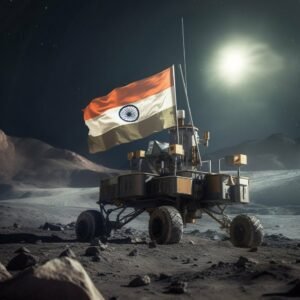Just days after the successful moon landing of Chandrayaan-3, the Indian Space Research Organisation (ISRO) has announced that the Vikram Lander has once again achieved a “soft landing” on the lunar surface. ISRO reported that Vikram Lander not only met but exceeded the mission objectives of Chandrayaan-3 by completing a “hop experiment.”

According to ISRO, the Vikram Lander executed the engine firing command, elevating itself by approximately 40 cm as anticipated, and safely landed 30 to 40 cm from its initial position.
Following its successful lateral jump, the Vikram lander has taken the following steps by redeploying the ramp and releasing the ILSA and ChaSTE payloads onto the lunar surface.
Meanwhile, preparations for the Pragyan rover’s endurance of the extended and severe lunar night, characterized by plummeting temperatures to below -180°C, have been completed.
The rover’s batteries have been fully charged; its solar panels are oriented toward the Sun to harness solar energy, and ground stations actively monitor for signals, ensuring its safety and functionality during this challenging lunar phase.
This remarkable achievement by Vikram Lander has energized and set the stage for future missions involving sample return and human exploration, as noted by ISRO.
In related developments, last week, the Pragyan rover of the Chandrayaan-3 mission was placed into “Sleep mode” with fully charged batteries and an active receiver. ISRO expressed hopes for a successful awakening to carry out additional tasks, emphasizing that otherwise, it would remain a symbol of India’s lunar presence as a lunar ambassador.
In preparation for the lunar night approaching the vicinity of Shiv Shakti Point, where the Chandrayaan 3 mission made its historic landing on August 23, 2023, Vikram will enter sleep mode. The planned scientific activities and operations of the mission have been completed.
Extensive ground tests have provided reassuring results, indicating that the instruments and equipment on board can endure the harsh lunar night and subsequently reactivate themselves on September 22, 2023, with the return of sunlight to the Shiv Shakti Point area. If all goes as planned, this will enable the Lander and Rover to resume their scientific endeavors.
India’s historic achievement with the Chandrayaan-3 mission, marking the first country to land near the moon’s south pole, has generated widespread excitement and pride. The soft and precise touchdown of Chandrayaan-3 contrasts with the earlier unsuccessful attempt in 2019, making it a meaningful scientific accomplishment for India and a source of national jubilation. This landing is one of India’s most significant scientific achievements in the past two decades.









